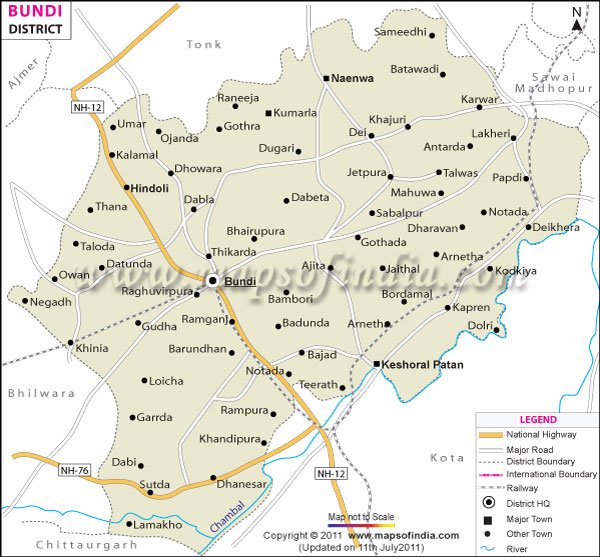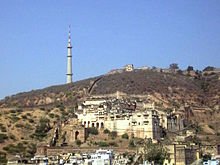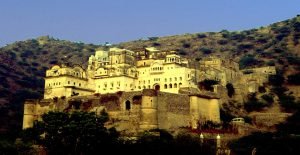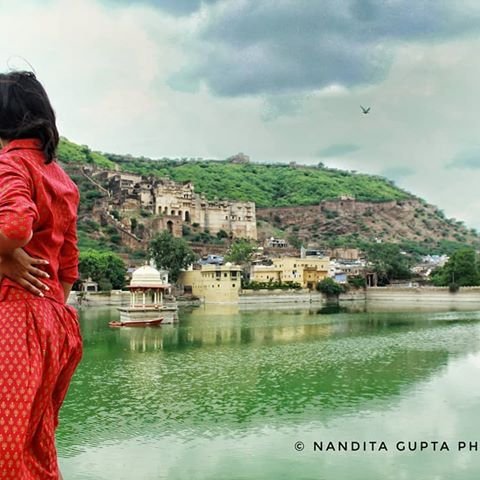BUNDI RAJASTHAN TOURRIEST PLACE AND HISTORY
location mape


History of Bundi
History of Bundi, now in the Rajasthan state of India.
In ancient times, the area around Bundi was apparently inhabited by various local tribes, of which the Parihar Meenas were
prominent. Bundi and the eponymous princely state are said to derive their names from a former Meena chief called Raja Bunda
Singh Meena. Bundi was previously called “Bunda-Ka-Nal", Nal meaning “narrow ways”. Bundi is situated in a narrow valley within
the Aravalli Hills in Rajasthan. Later the region was governed by Rao Deva Hada, who took over Bundi from Jaita Meena in 1342,
renaming the surrounding area as Haravati or Haroti. For the next two centuries, the Hadas of Bundi were the vassals of the Sisodias
of Mewar and ruled by the title of Rao until 1569, when Akbar conferred the title of Rao Raja upon Rao Surjan after the surrender of
Ranthambore Fort and his submission. In 1707,B ahadur Shah I conferred the title of Maharao Raja upon Raja Budh Singh[1.]
Rulers
Princely State
British era
Accession to India
References
Meena tribe ruled this area till 1342 CE. Later the rulers of Hadoti belonged to the Hada dynas.ty
Rulers of Bundi:
Rao Deva (1342 to 1343).
Rao Napuji.
Rao Hamuli (1384 to 1400).
Rao Birsingh (1400 to 1415).
Rao Biru (1415 to 1470).
Rao Bandu (1470 to 1491).
Rao Narayan Das (1491 to 1527).
Rao Suraj Mal (1527 to 1531).
Rao Surtan Singh (1531 to 1544).
Rao Raja Surjan Singh (1544 to 1585).
Rao Raja Bhoj Singh (1585 to 1608).
Rao Raja Ratan Singh (1608 to 1632).
Rao Raja Chhattar Sal Singh (1632 to 1658).
Rao Raja Bhao Singh (1658 to 1682).
Rao Raja Anirudh Singh (1682 to 1696).
Maharao Raja Budh Singh (b. ... – d. 1739) (1696 to 1735).
Maharao Raja Dalel Singh (b. 1729 – d. 1804) (1735 to 1749).
Maharao Raja Umaid Singh (1749 to 1770) and again (1773 to 1804).
Maharao Raja Ajit Singh (b. ... – d. 1773) (1770 to 1773).
Contents
Rulers
After 1818, Bundi came under British rule and became a Princely state.
In 1804 Rao Raja Bishan Singh (1773–1821) gave valuable assistance to Colonel
Monson in his disastrous retreat before Holkar, in revenge for which the Maratha
Empire and Pindaris continually ravaged his state and forced the kingdom to pay
tribute up to 1817. Consequently, Bishan Singh made a subsidiary alliance with the
British East India Company on 10 February 1818, which brought him under its
protection. was responsible for the creation of the pleasure palace of Sukh Niwas on
the outskirts of Bundi.
When dying of cholera, Bishan Singh entrusted James Tod with guardianship of his
11-year-old son, Ram Singh. Maharao Raja Ram Singh (1821–89) grew up to be a
much respected ruler who initiated economic and administrative reforms and
established schools for the teaching of Sanskrit. On the throne for 68 years, he was
described as a grand specimen of the Rajput gentleman and "the most conservative
prince in conservative Rajputana."[2] His rule was popular and beneficial; and
though during the mutiny of 1857 his attitude was equivocal, he continued to enjoy
the confidence of the British, being created G.C.S.I. and a counselor of the empire in
1877 and C.I.E. in 1878. He was succeeded by his adopted son Raghubir Singh
(1889–1927), who was made a K.C.S.I. in 1897 and a G.C.I.E. in 1901. His reign
was blighted by two disastrous famines. Despite his best efforts at alleviation, the
population of his kingdom was reduced from some 258,000 to 171,000 by 1901 due
to death and emigration.[2] Raghubir Singh supported the British during the World
War I.
Maharao Bahadur Singh (1945–77) also supported the British and served in the
Burma campaign, where he earned the Military Cross for his gallantry before
succeeding to the throne. He was a guest at the 1947w edding of Princess Elizabeth and Philip, Duke of Edinbugrh. [3]
At the time of the partition of India in 1947, the British abandoned their suzerainty over the princely states, which were left to decide
whether to remain independent or to accede to the newly independent Dominion of India or to Pakistan. The ruler of the state of
Bundi decided to accede to India, which later became the Union of India. This brought the internal affairs of Bundi under the control
of Delhi.
Watercolour painting of the town and
pass of Bundi in Rajasthan, by an
anonymous artist working in the
British school, c. 1840.
Sukh Niwas Palace on the edge of
the Jait Sagar tank at Bundi, c. 1900
famous place
chourasi khambo ki chatri,%20Bundi,%20Rajasthan%20(1683).jpg)
palace TARAGARH
 TARAGHAR
TARAGHAR
JAL MAHAL

OUTING PLACE WATERFALL 25 KM FROM BUNDI CITY RAMESHAWER MAHADEV TEMPLE

Congratulations @jj8100! You have completed the following achievement on Steemit and have been rewarded with new badge(s) :
Click on the badge to view your Board of Honor.
If you no longer want to receive notifications, reply to this comment with the word
STOPDo not miss the last post from @steemitboard:
SteemitBoard and the Veterans on Steemit - The First Community Badge.